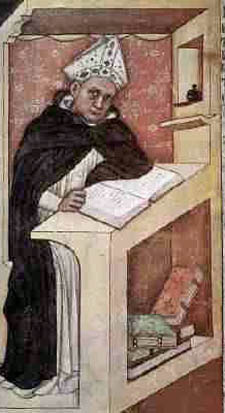 |
 |
Socio-Political Issues
Good Science, Bad Science
Joseph Sheppard
Contrary to popular opinion, the Church and science have worked harmoniously throughout History to the advantage of mankind. In fact, it was the Church that established the great universities of Europe and encouraged new discoveries about the truth of the natural world. The Sorbonne (Paris) in France, Oxford and Cambridge in England, and the renowned universities of Valladolid and Salamanca in Spain, Prague and Vienna of the Austrian Empire, Krakow in Poland, Heidelberg and Cologne in today’s Germany, and Bologna, Florence, and Padua in Italy, all owe their existence to a great extent to the Church.
 |
St. Albert the Great at a writing desk in his cell, by Tommaso da Modena |
Great saints of the Church are known for their advancement of science. St. Albert the Great is an excellent example of science at the service of the Church. St. Albert was a Dominican Bishop and regent of the University of Cologne. In modern terms he would be called a “Renaissance man”, except that he lived well before that time (1206-1280). He excelled in every subject and was considered the academic wonder of his age. He was theologian, philosopher and scientist. In modern parlance, one might say that he used the scientific method before the scientific method was “cool.”
Imagine a Catholic saint of the Middle Ages advising the following:
• “The aim of natural science is not simply to accept the statements of others, but to investigate the causes that are at work in nature” [De Miner., lib. II, tr. II, I]
• “Experiment is the only safe guide in such investigations” [De Veg., VI, II, I]
• “In studying nature we have not to inquire how God the Creator may, as He freely wills, use His creatures to work miracles and thereby show forth His power: we have rather to inquire what Nature with its immanent causes can naturally bring to pass” [Coelo et Mundo, I, tr. IV, X]
1. The Catholic Encyclopedia, entry “St. Albert Magnus,” online edition
Ironically, many occult sites on the Internet attempt to claim St. Albert as one of their own. Even in his own day, St. Albert was accused of being a sorcerer or magician due to his own incredible depth of knowledge and application of this knowledge. To the contrary, he expressed contempt for all that reeked of witchcraft or the art of magic:
“I do not approve the assertions of Avicenna and Algazel (Arab scholars) about witchcraft, which I believe are favorable to it and magic.” (2)
2. The Catholic Encyclopedia, ibid.
Also contrary to what some claim, St. Albert did not believe in the use of “philosopher’s stones” or that gold could be made by alchemy.
St. Albert was much more than a scientist, he was a philosopher and a theologian as well. The scientist observes and quantifies the natural world, measuring, noting changes and collecting data. The philosopher uses these data collected by the scientist and seeks to discover the reason the natural world is as we have found it. Finally, the theologian investigates how God’s will is manifested in the circumstances of the natural world.
Most of the modern science falls into the error of denying philosophy and theology. Sadly, the contemporary scientist is limited to a materialistic world to be manipulated however necessary to suit the whims of man, be they amoral or political. Eliminated from consideration is the reality of God and the spiritual realm in this science that substitutes philosophy and religion.
With such a limited palette, the theology of science must be one in which life creates itself, and the scientist has become the sorcerer or magician which science once despised. One might more easily believe in gold created through alchemy or the use of philosopher’s stones. For it would take much more faith indeed to believe that nature created itself, rather than to believe its cause is supernatural.
Modern science has once again “triumphed” in the Cobb County School System north of Atlanta. The parent of a Cobb County student had obtained 2,300 signatures from county residents on a petition requesting that the school district adopt science textbooks that mention theories other than evolution [i.e.: Godless creation] when explaining the origin of life. The school board, in order to placate those involved in the petition, had stickers placed in the existing textbooks that simply stated: “Evolution is a theory, not a fact.”
Other Cobb County parents, along with the ACLU, sued the school district claiming that the stickers were an attempt to force religion down the students throats and violated the separation of church and state. Federal Judge Clarence Cooper ruled Thursday [1-13-05] that putting the stickers in the books was unconstitutional because it violates the separation of church and state. (3) One wonders which “church” it was that wished to impose its beliefs on the nation by federal law. The Church of the Forbidden Sticker of Truth? The Church of Godless Creation?, or perhaps The Church of Magic?
3. The Marietta Daily Journal, “Board to eye evolution sticker ruling”, January 15, 2005, p. 1.

Posted January 27, 2005

Related Topics of Interest
 The Supernatural in Modern Society The Supernatural in Modern Society
 The Waning Authority of the Church in the Temporal Sphere The Waning Authority of the Church in the Temporal Sphere
 A Distributist Manifesto Strongly Spiced with Communism A Distributist Manifesto Strongly Spiced with Communism

|
Social-Political | Hot Topics | Home | Books | CDs | Search | Contact Us | Donate

© 2002- Tradition in Action, Inc. All Rights
Reserved
|
 |
|